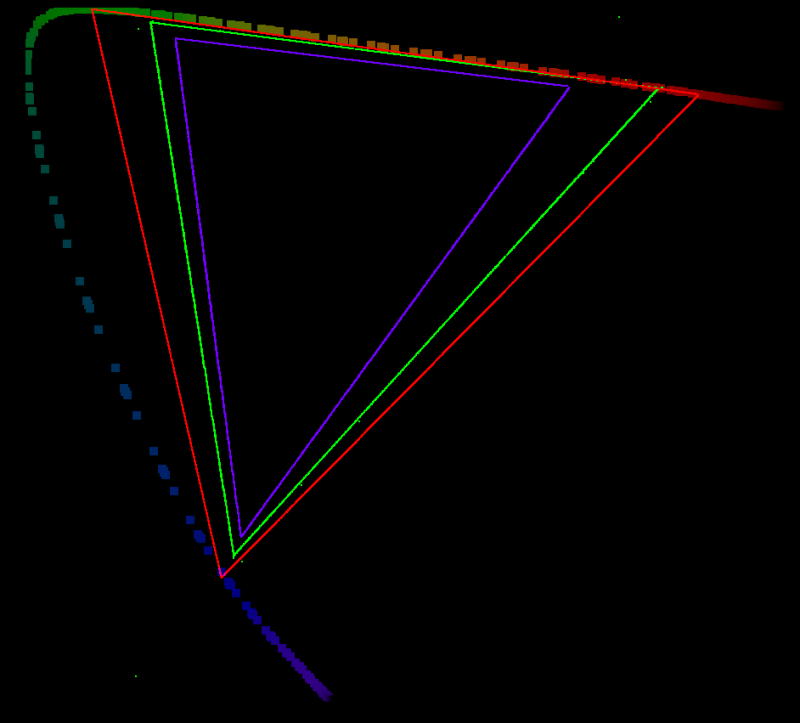-
Posts
17 -
Joined
-
Last visited
-
Hi, In case you are in NY at the NAB Show next week, drop by here: https://www.filmlight.ltd.uk/store/events/celebrating-look-color-new-york-26-october-2023/ I will give a talk about Look Development and our new Tool Chromogen. Would be nice to catch up. Regards Daniele
-
Film grade operates in the current stack colour space, so depending on the chosen working space the printer lights will do a different thing. Basegrade's bump have user customizable a/b ratios and are stack colour space independent. For very small shifts it might be similar, for larger shifts BaseGrade Bumps should give you a more robust result with cleaner blacks. Hope this helps.
-
You can use almost all metadata to build folder structure %{MetaData}. Checkout the little questionmark button next to the file path to get inspired. Also when you create a scene using the scene templates there are a few example deliveries already setup for you.
-
Hi, baselight STUDENT comes with the command line interfaces I think. just typ: ``` /Applications/BaselightSTUDENT/Current/Utilities/Tools/bl-shots ``` in your terminal
-
We are planning to expose many modules as APIs. But like with everything this needs lots of testing. We will start with what a typical pipeline TD would need, FileSystem Indexing, handling jobs and scenes, get and set metadata in a scene. Even today you can build powerful pipelines using CLIs like bl-conform and bl-shots. I hope this helps. Daniele
-
Hi Markus, try bl-shots on your Baselight, this is a CLI to swap VFX in a Baselight timeline. Also, notice that we are introducing: - Python API - Nuke style %V automated Versioning - support for OpenClip
-
Hi, the formula can be found on Wikipedia: https://en.wikipedia.org/wiki/ASC_CDL
-

From the Bl 4.4m1 some Grade looks are not Exporting
Daniele Siragusano replied to Soumitra Sarkar's topic in Baselight
Hi, BLGs in 4.4m1 do only support single input grades, because most of the other apps like Daylight, Baselight Editions etc… can only take one Input. In v5 we support Multi-Input BLGs, and Baselight for Nuke will be able to read and interpret "Multi-Input BLGs". I hope this helps -
To this time Baselight Student is macOS only. We understand that for some users this is unideal, but there are no plans at this point to port the Baselight app to Windows.
-

Baselight bypasses lift, gamma, and gain
Daniele Siragusano replied to Tom Evans's topic in Baselight
BaseGrade does not operate in Rlab, but constructs an optimised Achromatic Signal + two Colour Components. -

Cineon Log transform problem
Daniele Siragusano replied to Nicolas Hanson's topic in Editing , Color grading & Finishing
if you use the Truelight Video 1 inverse DRT, this is based on formulas rather than inverse LUTs. It gives normally a much smoother Result if you want to go from display referred to scene referred. This will a very common problem if you have stock or archive footage inside a project that needs HDR Deliveries. Also inverse Transforms cannot be avoided in certain situations (for example if you are forced to record film out) Simple Formula Matrix Colour Space conversions are used to convert from one space to the other without change the image state really. (scene to scene or display to display space conversion (within one viewing condition)), if you want to change the image state more complex transformations are needed. @Nicolas Hanson Which conversion did you used in the first place to produce the artefacts in your examples? -

Baselight with Avid ISIS Workspaces
Daniele Siragusano replied to Mark Mulcaster's topic in Baselight
if the network is unreliable, you can use input caching to only pull the media once. To do so select all stack tops, group grade and then press the little C button in the top right corner of the parameter view. Baselight will cache the input media in 16bit floating point. For quick TV turnarounds this might be overkill, but if you grade several days/weeks on one show it makes grading more stable and also reduces load on the FileServer. -
We will set the nclc to automatic in v5 when we introduce viewing condition dependent DRT Families.
-
When looking into projectors the Colour Gamut is not the only aspect you need to look at. Most "cheap" projectors do not meet other criteria, which are needed to judge a picture in a meaningful way: Most importantly: • Sequential and intra frame contrast • Luminance Uniformity • Colour Uniformity • Greyscale Tracking and more… There is a SMPTE Recommendation for Reference Projectors that describe all this: “SMPTE Recommended Practice for Digital Cinema” DC28.30 As suggested above I would rather do a first pass on a good monitor and then do a final trim in a proper grading theater. About Gamut Compression (because this is what you need to convert from P3 to 709 ) . Not many colours of a typical scene are outside of Rec709. Most of the pointer gamut (gamut of all surface colours) are within 709, so your image typically does not contain a great amount of data which cannot be represented in 709. visually the biggest impact is in Reds (attached a diagram in uv which is more visually meaningful than xy, the purple triangle is 709, green is p3 and red is 2020). You can have special highly saturated objects which have colours outside of 709 but humans are not very good in detecting errors in highly saturated colours. So if those special object look a bit different in the TV Version that is normally ok. Gamut Compression is normally used to convert from P3 to 709. This avoids gamut clipping which is much more unpleasing. best Daniele
- 22 replies
-
- 13
-

-

-

Baselight bypasses lift, gamma, and gain
Daniele Siragusano replied to Tom Evans's topic in Baselight
I was involved in Developing BaseGrade but I must say that Andi just nailed it… :-)



